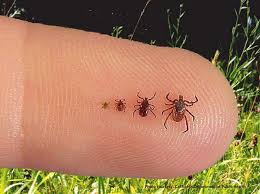 Ticks are as small as a pinhead: 1 to 3 mm. They look like spiders and live of blood.
Ticks are as small as a pinhead: 1 to 3 mm. They look like spiders and live of blood.
They live mainly in high grass and scrubs of forest, dunes, meadows, heathland, gardens and parks.
A tick bite is usually harmless. However, some ticks are the carrier of the Borrelia bacteria which can cause the Lyme disease.
During the blood meal flow with saliva anti- coagulant substances back into the wound.
The blood meals take several days to 1 or 2 weeks. The transmission of germs starts 24-48 hours after annealing. Therefore, rapid removal, preferably within 24 hours, is important.
Take the tick as close to the skin with a hook-shaped tweezers or a special tick tweezers. Beware that you do not press the tick down flat.
Slowly pull the tick from the skin. Do not turn, they have straight nozzles.
Disinfect the wound with alcohol or iodine.
Write down the date when symptoms should arise later. Attention to 3 months after the bite on whether there are symptoms. If a red ring larger than 5 centimeters appears on the skin, that can indicate the Lyme disease. In that case go to the doctor.
